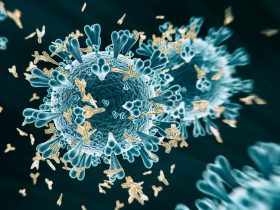The flu isn’t so bad – said no one ever! Despite unanimous disapproval for the bug, misconceptions continue to circulate that can increase risk of infection and escalate symptoms.
Here are 5 myths that healthcare providers probably hear a lot, patients likely cite too often, and scientific data debunks.
1. The flu vaccine can give you the flu.
An injected flu shot, regardless of the year’s specific formula, contains inactive viruses that cannot transmit infection. A flu vaccine administered via nasal spray contains diluted live viruses that can no longer cause the flu.
The myth survives because every year, without fail, some patients come down with the flu within two or fewer weeks after getting their flu vaccine. These patients were going to get the flu regardless of any flu vaccine.
The Centers for Disease Control and Protections (CDC) states, “It takes about two weeks after vaccination for antibodies to develop in the body and provide protection against influenza virus infection. That’s why it’s best to get vaccinated before influenza viruses start to spread in your community.”1 , 2
2. Healthy people don’t need a flu vaccine.
Diet, exercise, mental health, sleep patterns – these healthy markers alone cannot guarantee immunity to the flu. The CDC puts it quite plainly: All persons aged 6 months of age and older are recommended for annual vaccination, with rare exception.3 CDC data, based on vaccine effectiveness from the 2019-2020 flu season, estimates that vaccinations prevented 7.5 million flu illnesses, 3.7 million flu medical visits, 105,000 flu hospitalizations, and 6,300 flu deaths.4
While no study definitively concludes that all 6,300 deaths due to influenza involved unhealthy persons, the CDC stands by its claim that a flu vaccine is the single most effective way to protect against the flu. That includes even the healthiest American.3
3. The flu is no big deal. Just ride it out and it will be gone in a few days.
Every year since 2010 , it’s estimated that the flu resulted in between 9 and 45 million illnesses, 140,000 and 810,000 hospitalizations and 12,000 – 61,000 deaths.5 Specific to pediatric flu stats during the 2019-2020 flu season, 166 children died, with pediatric hospitalization rates unusually high .6
So yes, the flu is a “big deal”; it’s not always gone in a few days; and there are steps that can reduce risk of serious complications.
Specific to complications, there are antiviral medications. Antivirals slow or stop viral replication from cell to cell. These medications are most effective if started within 48-hours of flu symptom onset. There is, however, some welcome evidence that antivirals may be beneficial when taken up to 4 or 5 days post-symptom onset – which is important for those at high risk for flu complications .7
4. An annual flu vaccination is 100% guaranteed to protect against catching the flu.
While data supports an annual flu vaccine as the #1 step to avoid catching the flu virus, it’s not foolproof. Flu vaccine effectiveness varies from season-to-season depending on the match between viruses in the vaccine and those in circulation. A person’s age and health status can also impact flu vaccine effectiveness.
To augment flu vaccine success, healthy habits known to thwart viral spread are also key.
- Social distance
- Mask up – or better yet, stay home when sick
- Wash your hands frequently
In fact, the CDC credits measures such as these for a record-low number of flu cases during the 2020-2021 season (as of February 2021 ).8 Granted, most Americans’ adherence to viral-fighting healthy habits is to slow or prevent the spread of SARS-CoV-2, but there’s no denying that precisely as these habits caught on, flu cases plummeted.
5. Chicken soup speeds flu recovery.
In the 12th century, Moses Maimonides, noted physician and philosopher, wrote about chicken soup’s many benefits in his book Medical Responsa. He cited the golden elixir as a cure for everything from leprosy to a runny nose .9
While Dr. Mom is less generous with chicken soup’s healing capabilities, there is a general consensus that the broth does at least alleviate cold and flu symptoms.
Modern science says this is a myth. Or maybe not. Or perhaps it’s true but with qualifications. In other words, the jury is still out as to whether chicken soup speeds flu recovery.
A 2000 study, published in CHEST, suggested that chicken soup may possess a mild anti-inflammatory effect that could mitigate symptomatic upper respiratory tract infections typically associated with cold and flu.10
In another study, first presented in 1993, repeated in 2011, and yet to be invalidated as of 2021, University of Nebraska Medical Center physician and researcher Stephen Rennard, MD, found that chicken soup may ease the symptoms of upper respiratory tract infections . Dr. Rennard tested vats of chicken soup in his lab, and his concluding theory is that some ingredient in the soup “blocks or slows the number of cells congregating in the lung area, possibly relieving the development of these cold symptoms.”11
While no one has disproven the theory, a biological basis remains unclear and Dr. Rennard has never been able to identify the exact chicken soup ingredient that makes it effective against fighting viruses. So, his research team admits, the curative benefits may in fact be a combination of chicken plus vegetables plus herbs in the soup.
There is one thing that almost everyone – patient, physician, and researcher alike – agrees on. When the flu bug attacks, a fresh hot bowl of chicken soup feels pretty good going down.
Sources
1. Centers for Disease Control and Protection; Key Facts About Seasonal Flu Vaccine; retrieved at https://www.cdc.gov/flu/prevent/keyfacts.htm#:~:text=Does%20flu%20vaccine%20work%20right,to%20spread%20in%20your%20community.
2. National Foundation for Infectious Diseases; Myths and Facts About Influenza (Flu); retrieved at https://www.nfid.org/infectious-diseases/myths-and-facts-about-influenza-for-consumers/
3. Centers for Disease Control and Prevention; Who Should and Who Should NOT get a Flu Vaccine; retrieved at https://www.cdc.gov/flu/prevent/whoshouldvax.htm
4. Centers for Disease Control and Prevention; CDC 2020-2021 Flu Vaccine Campaign Kickoff; retrieved at
https://www.cdc.gov/flu/spotlights/2020-2021/2020-21-campaign-kickoff.htm
5. https://www.cdc.gov/flu/about/burden/index.html#:~:text=While%20the%20impact%20of%20flu,61%2C000%20deaths%20annually%20since%202010.
6. https://www.aappublications.org/news/2020/04/10/fluupdate041020
7. The Centers of Disease Control and Prevention; CDC Health Update Regarding Treatment of Patients with Influenza with Antiviral Medications; retrieved at https://emergency.cdc.gov/han/han00375.asp#:~:text=Observational%20studies%20of%20hospitalized%20patients,5%20days%20after%20symptom%20onset.
8. The Centers for Disease Control and Prevention; Weekly U.S. Influenza Surveillance Report; retrieved at https://www.cdc.gov/flu/weekly/index.ht
9. Fred Rosner, Therapeutic Efficacy of Chicken Soup, Chest, Volume 78, Issue 4, 1980, Pages 672-674, ISSN 0012-3692, https://www.sciencedirect.com/science/article/pii/S0012369216402461
10. Rennard BO, Ertl RF, Gossman GL, Robbins RA, Rennard SI. Chicken soup inhibits neutrophil chemotaxis in vitro. Chest. 2000 Oct;118(4):1150-7. doi: 10.1378/chest.118.4.1150. PMID: 11035691. Retrieved at https://pubmed.ncbi.nlm.nih.gov/11035691/
11. University of Nebraska Medical Center Newsroom; Got a cold or flu? UNMC researcher says try chicken soup to ease symptoms; retrieved at https://www.unmc.edu/news.cfm?match=9973








Leave a Reply